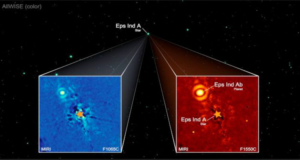RNS: In a monumental breakthrough for space exploration, an international team of astronomers, including Dr. Prashant Pathak from IIT Kanpur, has discovered a colossal planet orbiting a nearby star similar to our Sun.
The newly discovered exoplanet, named Epsilon Indi Ab (Eps Ind Ab), is classified as a ‘super-Jupiter’ due to its mass being at least six times greater than Jupiter’s, making it significantly larger than any planet in our solar system.
Eps Ind Ab is distinguished as the first mature exoplanet to be identified through direct imaging techniques. The discovery was made possible using the James Webb Space Telescope’s (JWST) Mid-Infrared Instrument (MIRI). The findings were recently published in the prestigious scientific journal Nature.
The planet orbits the K5V-type star Epsilon Indi A (also known as HD 209100 or HIP 108870) and is located approximately 12 light-years away from Earth. It boasts a frigid temperature of about -1°C (30°F) and orbits its star at a distance 28 times greater than the distance between Earth and the Sun.
Direct imaging, as opposed to indirect methods like gravitational influence or starlight dimming, provided a clearer observation of the exoplanet. This technique leverages JWST’s high sensitivity and infrared capabilities to capture the faint light of distant planets.
Elisabeth Matthews, a researcher at the Max Planck Institute for Astronomy in Heidelberg and the lead author of the study, expressed her excitement: “We were thrilled to capture this new planet. The bright spot in our MIRI images initially did not match our expectations for the planet’s position. Previous studies had underestimated the planet’s mass and orbital separation, but JWST enabled us to correct these errors.”

Professor Manindra Agrawal, Director of IIT Kanpur, highlighted the significance of this discovery: “This breakthrough in exoplanet research is a major milestone. The ability to directly image a nearby planet offers unprecedented opportunities for further study, showcasing IIT Kanpur’s global contribution to space science.”
Dr. Prashant Pathak, Assistant Professor at IIT Kanpur’s Department of Space, Planetary & Astronomical Sciences & Engineering (SPASE), emphasized the importance of this discovery: “Eps Ind Ab presents a unique opportunity to explore planets vastly different from those in our solar system. Its atmospheric composition suggests a high metal content and an unusual carbon-to-oxygen ratio, which raises intriguing questions about its formation and evolution.”
Previous attempts to study Eps Ind Ab using radial velocity measurements were unsuccessful due to its lengthy orbital period of around 200 years. The direct imaging method employed by the team used JWST’s MIRI camera, equipped with a coronagraph to block starlight and reveal the planet’s faint signal.
Looking ahead, the team plans to obtain spectral data for a detailed analysis of Eps Ind Ab’s climatology and chemical composition. Thomas Henning, Emeritus Director at MPIA and co-PI of the MIRI instrument, stated, “Our future goals include observing other nearby planetary systems to search for additional cold gas giants and to better understand their formation and evolution.”




